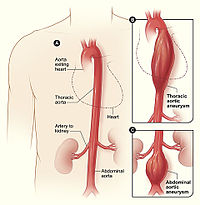
Photo from wikipedia
Objective: To evaluate the clinical outcomes of F/BEVAR among octogenarians. Databases were systematically searched for studies that compared outcomes following F/BEVAR between octogenarians and non-octogenarians. The primary outcome measures were… Click to show full abstract
Objective: To evaluate the clinical outcomes of F/BEVAR among octogenarians. Databases were systematically searched for studies that compared outcomes following F/BEVAR between octogenarians and non-octogenarians. The primary outcome measures were peri-operative mortality, survival, re-intervention, aortic rupture, and aneurysm-related deaths. Secondary outcomes were peri-operative outcomes. Seven studies published between 2017 and 2022 were included reporting on a total of 7,552 patients (>80yrs, 1536; <80yrs, 6016). More males (OR [95% CI] 0.83 [0.73-0.94], p.003), smokers (OR 0.50 [0.43-0.58], p<.001) patients with ASA >3 (OR 0.72 [0.52-0.98], p=.04), hypercholesterolaemia (OR 0.56, [0.42-0.73], p<.001), and pulmonary disease (OR 0.75, [0.66-0.86], p<.001) were observed in non-octogenarians. There was no significant difference in the peri-operative mortality between the two groups, but the hazard of overall mortality during follow-up was significantly higher in the octogenarian group (HR 1.67 [1.27–2.20], p<.001). There was no statistically significant difference in re-intervention (HR 0.96, [0.85-1.09], p=.057) or aneurysm-related deaths (OR 0.02, [-0.02-0.07], p=.31) between the two groups, but older patients were at greater risk of aortic rupture during follow-up (OR 4.71, [1.73–12.85], p=.002). Octogenarians were at a greater risk of intra-operative blood loss (WMD 54.73 [17.89-91.58], p=.004), endoleaks on completion angiogram (ORs 1.42, [1.20-1.67], p<.001), cardiac events (1.34 [1.12-1.62], p=.002) and endoleaks during follow-up (OR 1.40[1.03-1.91], p=.03). The body of evidence for most primary outcomes was judged to be low. Survival is lower in octogenarians but there was no significant difference in aneurysm-related deaths or re-interventions, despite the increased incidence of aortic rupture and endoleaks during follow-up.
Journal Title: British Journal of Surgery
Year Published: 2023
Link to full text (if available)
Share on Social Media: Sign Up to like & get
recommendations!